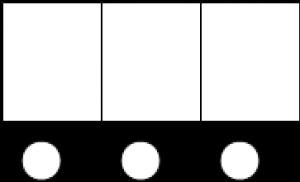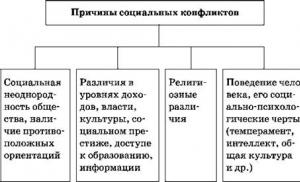Types and styles of interaction in psychology. Business communication styles
In modern educational and scientific literature, there are many definitions of the concept of "communication style". Analysis of these sources makes it possible to give the following definition.
Communication style- this is a set of methods of interaction with a partner / partners, embodied in certain forms and having an appropriate nature of implementation, contribute to the creation of interpersonal relations.
Today, the psychological and pedagogical literature presents a wide range of classifications of communication styles: Kurt Levin (authoritarian, democratic, liberal), Sergei Bratchenko (dialogical, authoritarian, manipulative, alterocentric, conformal, indifferent), Larisa Petrovskaya (ritual, manipulative, humanistic), Vladislav Latinov (alienated, obedient, balanced, protective, domineering), Valentina Goryanina (suffocating, unique, partner), Victor Kan-Kalik (communication-joint activity, communication-friendly interaction, communication-distance, communication-intimidation, communication-flirting , communication-advantage), Sergei Shein (trust-dialogical, altruistic, conformal, passive-indifferent, reflexive-manipulative, authoritarian-monological, conflict), etc.
Consider the time-tested and most versatile the classification of communication styles, created on the basis of the classification of management styles by Kurt Lewin.
The study of communication styles historically, preceded by experiments Kurt Levin aimed at creating a classification of management styles. The first was an experiment Ronald Lippit, pupil Levin, which was held in 1938 with the participation of ten-year-old children. The subjects met after school to create theatrical masks. The researcher divided them into two groups, in which they behaved in accordance with the authoritarian and democratic management styles. In the first pear, he made a decision alone and made the children follow them. The second group had the opportunity to choose the type of activity and participate in decision-making. Observation of the behavior of children showed that in a group with an authoritarian management style, children more often quarreled and showed hostility towards each other. When faced with problems, members of such a group were more likely to be inclined to find the "extreme" rather than to seek a way out of the predicament. In a group with a democratic management style, the children were more friendly to each other, easier to find ways to overcome the problems that arose.
In the same 1938, K. Levin, together with colleagues (Ronald Lippit and Ralph White), decided to conduct a similar experiment with an increased number of participants. They formed four "clubs" in which ten-year-olds were involved in a variety of activities. To the tested two styles (authoritarian and democratic), they decided to add a third - neutral, which was later called liberal. The addition of style happened by accident - one of the experimenters began to behave too softly, thereby giving the children the opportunity to decide everything on their own. Levin, who was observing the course of the experiment, immediately noticed this and proposed to single out a third style.
Every six months, the leader in the groups changed and, accordingly, the management style. As a result, the researchers made the following conclusions: the authoritarian management style was the reason for the increased aggression and cruel jokes on the part of children; an increase in aggression was also noted after the transition from authoritarian to neutral (liberal) style; all groups preferred the democratic style. It was found that the transition from authoritarian to democratic style takes longer than vice versa - from democratic to authoritarian. It was on the basis of this study that Kurt Lewin, according to the memoirs of his student, colleague and biographer Albert Morrow, stated: "Autocracy is inherent in man, but democracy must be learned";
Authoritarian communication style characterized exclusively by the sole decision of the subject of interaction of all issues concerning both the general life activity with another subject, and the subject's own life. Thus, the subject, on whom the authoritarian influence is directed, acts as an object. The subject of influence, based on his own attitudes, independently determines the goals of communication, biasedly evaluates the results of joint activities. In an exaggerated form, this style manifests itself in an autocratic approach to communication, in which the other parties of the interaction do not participate in the discussion of issues that are directly related to them, and their initiative is assessed negatively and refuted. The authoritarian style of communication is often realized through the use of diktat and overprotectiveness. The opposition of the other side to the tough pressure of the supporter of the authoritarian style often leads to the emergence of protracted conflict situations.
People who adhere to this communication style prevent others from showing independence and initiative. Their assessment of interaction partners is inadequate and is based mainly on subjectivity of attitude. The authoritarian interlocutor focuses on negative behaviors without taking into account her motives. External indicators of the success of the interaction of authoritarian interlocutors are most often positive, but the socio-psychological climate is predominantly unfavorable.
According to many researchers, the authoritarian style of communication contributes to the development of inadequate self-esteem of students, justifies the use of force, increases the possibility of neuroses, and forms an inadequate level of claims in communicating with others. In addition, the dominance of authoritarian methods in communicating with a person leads to a distorted understanding of values, a high assessment of such personality qualities as irresponsibility, imperiousness; cultivating the importance of external attractiveness and physical strength.
Liberal communication style characterized by the desire of the subject of interaction to be minimally involved in joint activities, which is explained by the removal of responsibility for its results. Such people participate in communication mainly formally, weakly concentrating on the essence of the process. The liberal style of communication is realized on the basis of non-interference, the basis of which is indifference and disinterest in the problems of another person and his environment. This often results in a lack of control over the communication process.
Proponents of this style shy away from making a decision, transferring the initiative to the interaction partner. The organization and control of activities, in the process of which the liberal style of communication prevails, is carried out haphazardly, the indecision of partners is manifested, hesitation in situations of choice. The application of this style in practice may seem democratic, but due to passivity, disinterest, unclear goals of interaction and lack of responsibility, the communication process becomes almost unmanageable. Groups dominated by the liberal style of communication are characterized by the instability of the socio-psychological climate and the presence of latent conflicts.
Democratic communication style is an alternative to the styles described above. According to this style of communication, the subject of interaction is focused on increasing the subjectivity of his partner, his involvement in solving common affairs. The main feature of this style is mutual acceptance and understanding. As a result of an open and free discussion of problems, the subjects of interaction come to one or another solution together. The democratic style of communication with people ensures the organization of joint activities in a team.
The methods of influence within the framework of the democratic style are motivation to action, requests, recommendations. Partners of people who prefer a democratic style of communication are more often characterized by a state of rest and satisfaction of their own needs, the presence of high self-esteem. "Democrats" pay more attention to their psychological characteristics, have a high level of professional stability, and are satisfied with their profession.
People who adhere to this style are characterized by a positive attitude towards the subjects of interaction; adequate assessment of their NPC capabilities, successes and failures; deep understanding of the partner, goals and motives of his behavior; the ability to predict the development of relationships. In terms of external signs of interaction with others, people of the democratic style of communication are inferior to the authoritarian, but the socio-psychological climate in the groups where they are is always more favorable. Interpersonal relationships in them are distinguished by trust and high demands on themselves and others. According to the democratic style of communication, a person stimulates others to be creative, to show initiative, creates conditions for joint self-realization.
Among the modern classifications of communication styles, it is advisable to highlight classification by Sergey Bratchenko, which highlights six communication styles, which, from his point of view, are manifested both in interpersonal and professional communication.
Dialogue style- orientation towards equal communication based on mutual respect and trust, orientation towards mutual understanding, mutual openness and communicative cooperation, striving for mutual self-expression, development, cooperation.
Authoritarian style- orientation towards dominance in communication, the desire to "suppress" the personality of the interlocutor, to conquer him to oneself, "communicative aggression", cognitive egocentrism, the requirement to "be understood", expectations of agreement with one's own position, unwillingness to understand the interlocutor, disrespect for another's point of view, orientation toward stereotyped communication, communicative rigidity.
Manipulative style- orientation towards using the interlocutor and the entire communication process for their own purposes, to obtain different types of benefits, attitude towards the interlocutor as a means, an object of their manipulations, the desire to understand the interlocutor in order to obtain the necessary information, combined with their own secrecy, insincerity, orientation towards "Trick" in communication.
Alterocentric style- voluntary "centering" on the interlocutor, orientation towards his goals and needs, disinterested sacrifice of his interests, goals, the desire to understand the needs of the other in order to satisfy them as fully as possible, but indifference to understanding himself on his part, the desire to contribute to the development of the interlocutor, even to the detriment of his own development and well-being.
Conformal style- rejection of equality in communication in favor of the interlocutor, orientation toward submission to the power of authority, toward an "object" position for oneself, orientation toward uncritical "understanding", lack of desire for real understanding and the desire to be understood, focus on imitation, reactive communication, readiness " adapt "to the interlocutor.
Indifferent style- an attitude towards communication, in which its essence and problems are ignored, the dominance of an orientation towards "purely business issues", "withdrawal" from communication as such.
It is expedient to note that in real practice of interaction there is more often a "symbiosis" of the described communication styles.
Interactive side of communication - This is a conventional term denoting the characteristics of those components of communication that are associated with the interaction of people, with the direct organization of their joint activities.
If the communicative process is born on the basis of some joint activity, then the exchange of knowledge and ideas about this activity inevitably presupposes that the achieved mutual understanding is realized in new joint attempts to further develop the activity, to organize it. The participation of many people at the same time in this activity means that each must make his own special contribution to it, which allows us to interpret the interaction as the organization of joint activities.
During it, it is extremely important for the participants not only to exchange information, but also to organize an "exchange of actions", to plan common activities. With this planning, it is possible to regulate the actions of one individual by "plans that have matured in the head of another", which makes the activity truly joint, when its carrier is no longer a separate individual, but a group. Thus, the question of which "other" side of communication is revealed by the concept of "interaction" can now be answered: the side that fixes not only the exchange of information, but also the organization of joint actions , allowing partners to implement some common activity for them. Such a solution to the issue excludes the separation of interaction from communication, but also excludes the identification of them: communication is organized in the course of joint activity, "about" it, and it is in this process that people need to exchange both information and the activity itself, that is, to develop forms and norms of joint action.
Interaction styles
Each situation dictates its own style of behavior and actions: in each of them a person “presents” himself in different ways, and if this self-presentation is not adequate, interaction is difficult. If a style is formed on the basis of actions in a particular situation, and then mechanically transferred to another situation, then, naturally, success cannot be guaranteed. There are four main styles of action: ritual, imperative, manipulative and humanistic.
1. Ritual style of action. Using the ritual style as an example, it is especially easy to show the need to correlate the style with the situation. The ritual style is usually determined by some culture. For example, the style of greetings, the questions asked at the meeting, the nature of the expected responses. So, in American culture, it is customary to answer the question: "How are you?" answer “Excellent!”, no matter how things really are. It is typical for our culture to answer “in essence”, moreover, not to be ashamed of the negative characteristics of our own being (“Oh, there is no life, prices are rising, transport does not work,” etc.). A person accustomed to a different ritual, having received such an answer, will be puzzled as to how to interact further.
2. Imperative style- This is an authoritarian, directive form of interaction with a communication partner in order to achieve control over his behavior, attitudes and thoughts, forcing him to certain actions or decisions. The partner in this case is the passive side. The ultimate unveiled the goal of imperative communication is to coerce a partner. Orders, prescriptions and requirements are used as means of influencing. Areas where imperative communication is used quite effectively: the "boss - subordinate" relationship, military charter relations, work in extreme conditions, in extraordinary circumstances.
3. Manipulative style- This is a form of interpersonal interaction in which the influence on the communication partner in order to achieve their intentions is carried out secretly. At the same time, manipulation presupposes an objective perception of the communication partner, while the hidden desire is to gain control over the behavior and thoughts of another person. In manipulative communication, the partner is perceived not as an integral unique personality, but as a carrier of certain properties and qualities "necessary" for the manipulator. However, a person who has chosen this type of relationship with others as the main one often ends up becoming a victim of his own manipulations. He, too, begins to perceive himself in fragments, switching to stereotypical forms of behavior, guided by false motives and goals, losing the core of his own life. Manipulation is used by dishonest people in business and other business relationships, as well as in the media when the concept of "black" and "gray" propaganda is implemented. At the same time, the possession and use of means of manipulative influence on other people in the business sphere, as a rule, ends for a person with the transfer of such skills to other areas of relationships. Relationships built on the principles of decency, love, friendship and mutual affection are most destroyed by manipulation.
4. Humanistic style of interaction. It is possible to single out those interpersonal relationships where the use of the imperative is inappropriate. These are intimate-personal and marital relations, child-parent contacts, as well as the entire system of pedagogical relations. Such relationships are called dialogical communication. Dialogue communication within the framework of the humanistic style is an equal subject-subject interaction with the goal of mutual cognition, self-knowledge of communication partners. It allows you to achieve deep understanding, self-disclosure of partners, creates conditions for mutual development.
It is important to draw a general conclusion that the dismemberment of a single act of interaction into such components as the positions of the participants, the situation and the style of action, also contributes to a more thorough psychological analysis of this side of communication, making a certain attempt to link it with the content of the activity.
The main characteristics of interaction are manifested in different ways based on the conditions and situations in which the participants in the pedagogical process interact, which allows us to speak of a variety of types of interaction. There are various grounds for classification.
· Interactions prioritize by subject and object to subject:
- personality - personality (student - student, teacher - student, teacher - teacher, teacher - parent, etc.);
- collective - collective (junior collective - senior collective, class - class, student collective - pedagogical collective, etc.).
Each of these types has its own characteristics based on age: interaction of the same age and age, interaction in the team of younger and older students, etc.
· Celebrate direct and indirect interaction.
Direct interaction characterized by direct impact on each other, indirect the same directed not at the person itself, but at the circumstances of her life, its microenvironment. For example, a teacher, organizing collective cognitive activity, interacts directly with consultants, on whose activities the participation of other students in the work depends. Consulting his assistants, the teacher directs their attention and actions to each student, gives advice on how to involve his comrades in the work. Through consultants, the teacher corrects the activities of other children with whom interaction is carried out indirectly.
· The basis for the classification of types of interaction can also be:
- the presence of a goal or its absence - a special goal can be set in the interaction, then it is customary to call it purposeful; or the goal may be absent, and then they speak of spontaneous interaction;
- the degree of controllability - controlled, semi-controlled, uncontrolled; controlled - purposeful interaction, accompanied by systematic information about its results, allowing you to make the necessary adjustments in subsequent interaction; semi-guided - ϶ᴛᴏ also purposeful interaction, but feedback is used from case to case; uncontrollable - ϶ᴛᴏ spontaneous interaction;
- type of relationship - "on equal terms" or "leadership"; for interaction "on equal terms" the subject is characteristic - subject relations, activity on both interacting sides; with "leadership" - activity on the one hand.
In practical work, characterize the interaction by optimality, efficiency, frequency and sustainability... Different approaches to the classification of interaction types do not exclude each other, but once again emphasize the multidimensional and multifaceted nature of this process.
We took the nature of the interaction as a basis for the classification, highlighting the following three features:
- the attitude of the interacting parties to the interests of each other,
- the presence of a perceived common goal of joint activities,
- the subjectivity of the position in relation to each other in interaction.
· Various combinations of these signs give certain types of interaction: cooperation, dialogue, agreement, custody, suppression, indifference, confrontation.
This typology is applicable to the characteristics of the interaction of participants in the educational process at all levels: teacher - student, student - student, teacher - teacher, etc. The most effective type of interaction for the development of the team and personality is the collaborative type of interaction, which is characterized by:
- objective knowledge, relying on the best sides of each other, the adequacy of their assessments and self-assessments;
- humane, benevolent and trusting, democratic relationships;
- the activity of both parties, jointly conscious and accepted actions, a positive mutual influence on each other, in other words, a high level of development of all its components.
Cooperation participants in the educational process - ϶ᴛᴏ joint determination of the purpose of the activity, joint planning of the upcoming work, joint distribution of forces, means, subject of activity in time in accordance with the capabilities of each participant, joint control and evaluation of the results of work, and then forecasting new goals and objectives.
MINISTRY OF EDUCATION OF THE RUSSIAN FEDERATION
CHEREPOVETSK STATE UNIVERSITY
INSTITUTE OF PEDAGOGY AND PSYCHOLOGY
DEPARTMENT OF PSYCHOLOGY
Abstract on the psychology of communication
Conflict interaction styles
Completed: student
group 4ps-22
Sapozhnikova E.S.
Checked by: Ph.D., associate professor
Khromov V.V.
Cherepovets
Introduction 3
General concept of conflict 4
Conflict interaction styles 6
Conclusion 12
List of used literature 13
Introduction.
No area of human life is free from conflict. Conflict is clashes, serious disagreements, during which a person is overwhelmed by unpleasant feelings or experiences. Conflicts are ineradicable, they appear under any life circumstances and accompany us from birth to death.
Conflicts are external (conflict with other people) and internal (conflict with oneself). In internal conflicts, there is no external opponent. However, this does not mean that internal conflicts are a trifle or that they are not important for decision making. Internal conflicts determine our value system, often the verdict "true" or "false" is the result of internal conflict. These conflicts are the basis of ethics and morality. If people in certain situations did not feel internal conflict, they would never think about questions of morality. The concept of "internal conflict" is very close to the concept of "conscience".
Apart from the fact that conflicts do not give any pleasure to most people, modern medical scientists note the devastating consequences of stress, most of which are caused by conflict. Resolving conflicts is about solving human problems. Resolving a conflict almost certainly means maintaining the relationship. If this were not the case, people would not try to resolve conflicts.
Of course, a recognized, serious, deeply felt conflict takes its toll, but if there is an intention to settle it, the likelihood that it will be possible to preserve the relationship in their inner, deep manifestation is very high. It is very important that the parties objectively assess each other and make possible efforts to recognize the value and importance of their relationship, even in their current conflict. This step is equally suitable for disputes between teacher and student, mother and children, between husband and wife.
General concept of conflict
There is no shortage of different definitions of conflict. We will present several of them, each of which reveals and emphasizes one side or another of this dynamic group process:
* Conflict is usually seen as a state of disagreement about the ability to dispose of limited resources;
* Conflict is a state of relations between people when at least one of them is angry, irritated, hostile towards the other, criticizes his actions, which leads to a stop of productive work and a violation of moral balance;
* Conflict is a function of the degree or amount of interdependence and interaction between people: the more our dependence on others or the more we expect from them, the more likely the conflict and the fact that it will be strong;
* Conflict is an interactive state that manifests itself in disagreement, differences or incompatibility within or between social units: individuals, groups, organizations, etc. The conflict arises at different intra- and inter-personal levels:
a) an intra-individual conflict arises when a person must perform certain actions, roles that do not correspond
his skills, interests, goals or values;
b) Intragroup conflict refers to the conflict between members of the group;
c) intergroup conflict - a conflict between representatives of two or more groups.
Despite the ambiguity, the term "conflict" has a very definite meaning, one way or another manifested in many definitions. First, the conflict must be perceived by its participants. Many situations that could be regarded as conflict situations, in fact, are not such, because people involved in them do not perceive their relationships as conflicting. Secondly, for a conflict to arise, contradictions in motives, interests, values, positions of at least two parties are necessary. The exception, as it might seem, is an intrapersonal conflict, however, here, too, there are discrepancies between the real and the desired situation for the individual.
Third, a conflict is always a struggle for the possession of resources - money, work, prestige, power, time - that are limited, which have to be distributed among the parties interested in obtaining them.
The main difference between definitions of conflict concerns, in most cases, two points. A conflict can be viewed either as a deliberate opposition of the interests of the parties, or as a result of a combination of circumstances. On the other hand, the discrepancy between points of view concerns whether open confrontation is a mandatory criterion for the presence of a conflict or it can proceed in a latent form.
Styles of conflict interaction.
The following are possible styles of behavior in a conflict. Two dimensions are used here. Assertiveness i.e. the degree of self-interest and cooperativity orientation, i.e. the degree of orientation towards the interests of the opposite party involved in the conflict. Accordingly, five orientations of behavior are distinguished: confrontation, cooperation, avoidance, adaptation and compromise.
Confrontation.
Confrontation tactics are about actively and stubbornly confronting their opponents, despite their attempts to reach a compromise or go to reconciliation. She suggests:
Insisting on one's position, point of view without their clear designation;
Intemperance, irritability, when a partner tries to oppose his opinion, position, opinion or position of a given subject;
Weak variability of goals, even with a high dynamism and variability of the situation and interaction;
General conservatism of interests;
Intolerance to someone else's opinion and someone else's will;
The short-term nature of the stage of the conflict situation, the use of minor reasons to transfer it to the stage of the incident;
The protracted nature of incidents, their severity and emotional intensity;
Assessing your engagement partners as having biases against them.
The main tasks solved during the conflict when using the confrontation technique are the following:
Defending your interests or the interests of third parties, seeking truth;
The desire to persuade, to impose your opinion, decision, point of view;
Attempts to belittle their opponents, to prove the illegality of their position.
People who adhere to this tactic believe that there is "their point of view" and the wrong one. For them, the number of their supporters and opponents does not matter: even when left alone, they defend their positions.
This tactic is fraught with irreconcilable animosity, especially if it is adhered to by both sides. It is often chosen by teenagers.
For example, imagine the following situation. Dima and Seryozha are brothers of the same age, they are 17 and 16 years old. Mother, leaving for work, instructed them to vacuum the rooms. As soon as the door closed behind her, Dima began to pull on his boots. Seryozha took out a vacuum cleaner:
Eh, where did you run away like that? One room is mine, the other is yours!
Fuck off, kid.
No, Dimon, seriously, this is not the case! I won't clean up for you!
Aha, how will you be! I’ll tell my mother that you’re smoking, so you’ll vacuum for six months. Seven days a week!
Sergei is angry and silent. Dima smiles at last:
Chao, brother! Clean up my place!
This can be most clearly illustrated by the example of a conflict between a teenager and a parent. When I was 14, there was no end to my conflicts with my mom. Every morning began with a shout:
Helena! What are you wearing on yourself ??? It's cold outside, but she's wearing kapronochkas!
So what.
What? You understand that you will catch a cold! That you are in poor health!
Well, don't give a damn! My health!
Yes? And then you will go to infect me? Thanks!
I will wear what I want! I'm not little anymore! Don't you dare tell me!
Don't you dare be rude to me !!!
We did not speak in the evening.
Confrontation is acceptable when:
* quick decisive action is needed
* it is necessary to make an unpopular decision on important issues
* there is confidence in the correctness of the chosen important decision
* people manipulatively take advantage of their own position
Cooperation.
The tactic of cooperation is the desire to resolve a contradiction through active interaction with your partner. Its use dramatically increases the likelihood of a positive outcome of the conflict. Thus, not only the cause of dissatisfaction, tension is eliminated, but also greater mutual understanding, trust, and respect is achieved.
Distinctive features of cooperation:
Respectful attitude towards a partner, willingness to listen and understand their feelings and desires;
Assessing your position as important, but not the only possible one;
The desire to regulate their behavior in the direction of greater correctness;
Caring for the preservation of the relationship, despite the existing disagreements;
Focusing attention at the stage of conflict resolution;
Willingness to apologize;
The desire to act rationally and consciously;
Phased, consistency in achieving goals.
Of all the styles, collaboration is the most versatile. It is suitable both for single-level (horizontal) communication, and for resolving conflicts in vertical structures (between managers and subordinates, students and teachers), however, its use can be opposed by a number of personal qualities and attitudes (arrogance and conceit, suspicion, leadership attitude) ... Personal maturity, respect for people, responsibility contribute to the application of this style in practice.
2.2 Interaction situations and their styles
In management psychology, there are many classifications of interaction situations.
Each situation dictates its own style of behavior and actions: in each of them a person “presents” himself in different ways, and if this self-presentation is not adequate, interaction is difficult. If a style is formed on the basis of actions in a particular situation, and then mechanically transferred to another, then, naturally, success cannot be guaranteed. There are three main styles of action: ritual, manipulative and humanistic.
The ritual style is usually determined by some culture. His goal is not to change the other in communication, but simply to confirm his presence in this culture, in this situation, to declare his competence in it: for example, the style of greetings, questions asked at a meeting, the nature of the expected answers. So, in American culture, it is customary to answer the question: "How are you?" - to answer: “Great!”, no matter how things really are. It is common for our culture to answer “in essence,” and at the same time not be ashamed of the negative characteristics of our own being (“Oh, there is no life, prices are rising, transport is not working,” etc.). A person accustomed to a different ritual, having received such an answer, will be puzzled as to how to interact further. Non-observance of the ritual gives rise to an assumption about the person's incompetence, about his inability to observe the “rules of the game” (for example, prolonged trampling of a guest in the hallway, when the meeting is over long ago, can cause a negative assessment of behavior from the point of view of accepted norms).
As for the use of a manipulative style of interaction, the goal when using it is the intention to control, teach, influence, impose one's position. For the sake of manipulation, a wide range of means are used, such as distraction of attention, interception of initiative, "exploitation" of the personal qualities of the object of manipulation. The phenomenon of "foot-in-the-door" is widely known, when the influence on the partner is in portions: first, he is asked to make a small concession, and then imperceptibly subordinate him to the imposed opinion. The ability to resist a manipulative style depends on a number of factors: a sufficiently high self-esteem, the firmness of established beliefs, the ability to resist someone else's opinion, etc.
The humanistic style is manifested when the goal of interaction is not a change in the other, but a change in the ideas of both partners regarding the object of interaction. In relation to each other, the goal is mutual support. The humanistic style presupposes the corresponding awareness and even the experience of the interaction situation. Naturally, special attention is paid to the study of this style in humanistic psychology, in particular, in the works of K. Rogers.
Each style uses a variety of self-presentation techniques, from pleasing to intimidation. It is impossible to say unequivocally which of the named styles is "good" or "bad": in different situations and with different positions of the participants in the interaction, various combinations of behavior styles are possible. The most important thing for effective interaction is adequate coordination of all three components - position, situation and style.
It is important to draw a general conclusion that the dismemberment of a single act of interaction into such components as the positions of the participants, the situation and the style of action, also contributes to a more thorough psychological analysis of this side of communication, making a certain attempt to link it with the content of the activity.
2.3 Types of interactions
There is another descriptive approach to the analysis of interaction - the construction of classifications of its various types. The most common is the dichotomous division of all possible types of interaction into two opposite types: cooperation and competition. Different authors refer to these two basic species in different terms. In addition to cooperation and competition, they talk about agreement and conflict, adaptation and opposition, association and dissociation, etc. Behind all these concepts, the principle of distinguishing various types of interaction is clearly visible. In the first case, such manifestations of it are analyzed, which contribute to the organization of joint activities, are "positive" from this point of view. The second group includes interactions that in one way or another "shake" joint activity, which represent a certain kind of obstacle to it.
Cooperation, or cooperative interaction, means the coordination of the individual forces of the participants (ordering, combining, summing up these forces). The attributes of cooperation are such processes as mutual assistance of participants, their mutual influence, their involvement in interaction. Cooperation is a necessary element of joint activity, generated by its special nature. A. N. Leontiev named two main features of joint activity: a) the division of a single process of activity between the participants; b) change in the activity of each, since the result of each activity does not lead to the satisfaction of his needs, which in general psychological language means that the “object” and “motive” of the activity do not coincide.
How is the direct result of the activity of each participant connected with the final result of joint activity? The means of such a connection are the relations developed in the course of joint activities, which are realized, first of all, in cooperation. An important indicator of the "tightness" of cooperative interaction is the involvement of all participants in the process. Therefore, experimental studies of cooperation most often deal with the analysis of the contributions of the participants in the interaction and the degree of their involvement in it.
As for the other type of interactions - competition, here at the ordinary level, negative characteristics of this process are most often offered (including even its identification with enmity), which was noted in the above definition. However, a more careful analysis of competition allows us to endow it with positive features. In a number of studies, the concept of productive competition is introduced, characterized as humane, honest, fair, creative, in the course of which partners develop a competitive and creative motivation. In this case, although combat is preserved in the interaction, it does not develop into a conflict, but provides only genuine competition.
There are several degrees of productive competition, differing in the measure of such quality as “softness / rigidity”: a) competition when the partner does not pose a threat and the loser does not die (for example, in sports, the loser does not drop out, but simply occupies a lower place in the rating) ; b) rivalry, when only the winner turns out to be the unconditional winner, the other partner is in absolute loss (for example, the situation of the world chess championship), which means a violation of partnership, the emergence of elements of conflict; c) confrontation, when on the part of one participant in the interaction there is an intention to inflict damage on another, i.e. rivals turn into enemies. The boundaries between these degrees are, of course, conditional, but it is important that the last degree can directly develop into a conflict.
Conflict is sometimes viewed as a special form (or type) of interaction and is defined as the presence of opposite tendencies in the subjects of interaction, manifested in their actions. The specificity of the socio-psychological perspective on the conflict lies in the simultaneous analysis of two components: the conflict situation and its representation in the minds of the participants. This provided grounds for discussing the most important general theoretical problem of conflict - understanding its nature as a psychological phenomenon. Indeed: is the conflict just a form of psychological antagonism (i.e., the representation of the contradiction in the mind) or is it necessarily the presence of conflicting actions. A detailed description of various conflicts in their complexity and diversity allows us to conclude that both of these components are mandatory signs of a conflict.
The tasks of studying it can be successfully solved only if there is an adequate conceptual scheme for the study of the conflict. It captures at least four main characteristics of the conflict: structure, dynamics, function and typology of conflicts. Although the structure of conflict is described in different ways by different authors, its basic elements are almost universally accepted. This is a conflict situation, the positions of the participants (opponents), the object, the "incident" (trigger), the development and resolution of the conflict. These elements behave differently depending on the type of conflict. The common idea that any conflict necessarily has a negative meaning has been refuted by a number of special studies. Most scholars in this field usually name two types of conflicts: destructive and productive.
The definition of a destructive conflict is more in line with the common idea. It is this type of conflict that leads to a mismatch in the interaction, to its loosening. A destructive conflict often becomes independent of the cause that gave rise to it, and more easily leads to the transition "to the individual", which generates stress. It is characterized by a specific development, namely the expansion of the number of participants involved, their conflict actions, the multiplication of negative attitudes expressed towards each other, the acuteness of statements ("expansion" of the conflict). Another feature - "escalation" of the conflict means an increase in tension, the inclusion of a false perception of an increasing number of both the opponent's traits and qualities, and the situations of interaction themselves, the growth of prejudice against a partner. It is clear that the resolution of this type of conflict is especially difficult.
A productive conflict often arises when the collision does not concern the incompatibility of personalities, but is generated by the difference in points of view on a problem, on ways to solve it. In this case, the conflict itself contributes to the formation of a comprehensive understanding of the problem, as well as the motivation of the partner defending the other point of view - it is perceived as more "legitimate". The very fact of admitting another argumentation, recognizing its legitimacy contributes to the development of elements of cooperative interaction within the conflict, denotes the emergence of elements of a friendly atmosphere and thereby opens up opportunities for its regulation and resolution.
How to resolve the conflict is the most important part of the problem. As with communication, feedback plays an important role here, i.e. identifying the partner's reaction to the committed action. Feedback serves as a means of regulating the behavior of the parties to the conflict, which is especially evident in negotiations. The purpose of negotiations is to reach an agreement, the main method of which is a compromise, i.e. the agreement of each side to equally deviate from its previous position in order to bring them closer together. In the implementation of such a strategy, the role of a mediator or arbitrator, a representative of a third, neutral party, is important, contributing to the success of the negotiations.
When analyzing various types of interaction, the problem of the content of activity is fundamentally important, within the framework of which certain types of interaction are given. So, one can state a cooperative form of interaction not only in production conditions, but, for example, in the implementation of any asocial, illegal acts - joint robbery, theft, etc. Cooperation and competition are only forms of the "psychological pattern" of interaction, while the content in both cases is set by a broader system of activity, where cooperation or competition is included. Therefore, when studying both cooperative and competitive forms of interaction, it is unacceptable to consider them outside the general context of activity.
The specific content of various forms of joint activity is a certain ratio of individual "contributions" that are made by the participants. So, one of the schemes suggests distinguishing three possible forms, or models:
1) when each participant does his part of the common work independently of the others - “joint-individual activity” (for example, some production teams, where each member has his own task);
2) when a common task is performed sequentially by each participant - "joint-sequential activity" (example - a conveyor);
3) when there is a simultaneous interaction of each participant with all the others - "jointly interacting activities" (for example, sports teams, research teams or design bureaus)
Thus, the psychological pattern of interaction in each of these models is unique in each specific case.
CONCLUSION
Joint activity is a constantly acting factor of communication between members in a team. Business communication contributes not only to the solution of purely utilitarian problems, but also to the spiritual enrichment of those communicating. When analyzing the communicative side of communication, it was found that there is a certain relationship between the nature of communication and the relationships that exist between partners.
Interpersonal relationships determine both the type of interaction that occurs under given specific conditions (whether it will be cooperation or rivalry), and the result obtained (whether it will be more successful or less successful cooperation). In the process of joint activity, the emotional basis inherent in interpersonal relations, which generates various assessments, orientations, attitudes of partners, “colors” the interaction in a certain way.
But at the same time, such an emotional (positive or negative) coloration of interaction cannot fully determine the fact of its presence or absence: even in conditions of “bad” interpersonal relations, given by a certain social activity, interaction necessarily exists.
To what extent it is determined by interpersonal relations and, conversely, to what extent it is "subordinated" to the requirements of the activity performed, depends, inter alia, on the nature of social relations in which this activity is carried out.
BIBLIOGRAPHY
1. Andreeva G.M., Bogomolova N.N., Petrovskaya L.A. Contemporary foreign social psychology. M., 2001.
2. Bazarov T.Yu., Eremin B.L. Personnel Management. M., 2001.
3. Bern E. Games People Play. People who play games / Per. from English M., 1988.
4. Borodkin F.M., Karyak N.M. Attention: conflict! Novosibirsk, 2003.
5. Grishina N.V. The psychology of conflict. SPb., 2000.
6. Kunitsyna V.N., Kazarinova N.V., Pogolsha V.M. Interpersonal communication. SPb., 2001.
7. Leontiev A.N. Problems of the development of the psyche. M., 1972.
8. Lomov B.F. Communication as a problem of psychology // Methodological problems of social psychology. M., 1995.
10. Obozov N.N. Interpersonal relationships. L., 2005.
11. Parsons T. Concept of society: components and relationships / THESIS: Theory and history of economic and social institutions and systems. Almanac. - 1993, vol. I, no. 2.
12. Psychology of management: a textbook for universities. M.,
13. Solovieva O.V. Feedback in interpersonal communication. M., 1992.
14. Stolyarenko L.D. Psychology of business communication and management. - Rostov n / a: "Phoenix", 2001. - 512 p.

Collective. Optimally organized pedagogical communication allows you to effectively influence the socio-psychological climate of the team, prevent interpersonal conflicts. 2.2. FEATURES OF NON-VERBAL COMMUNICATION IN THE ACTIVITY OF THE TEACHER The content of the teacher's work is to promote the mental development of the student, and the main "tool" is his mental interaction with the child, ...




Between partners, here it is also necessary to trace how this or that interaction system is associated with the relations that have developed between the participants in the interaction. 3. Research of communication as interaction on the example of a group of students The relevance of this topic lies in the fact that not everyone understands that there is a relationship between temperament and abilities. In modern schools ...
Relationships are divided into formal (for example, a conversation between officials during office hours and informal (party, camping trip), business (official) and personal. Friendship is a form of interpersonal relations based on common interests and mutual affection. Friendship is inherent: personal character (in the opposite of, for example, a business relationship), voluntary and individual selectivity ...













